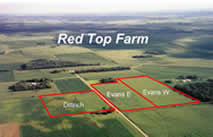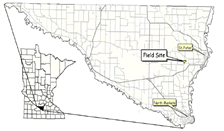
RED
TOP FARM DEMONSTRATION SITE
Red
Top Farm, in the Seven Mile Creek Watershed near the City of St. Peter,
is the site of a ninety-acre research field that provides a unique opportunity
to study the quality and quantity of water and agricultural chemicals
moving through a subsurface tile drainage system.
"If
there is something coming out of my tile lines I want to be the first
to know about it" says Rob Meyer, an Oshawa Township landowner. His
Red Top Farm fields are being continuously monitored for water quality
as part of an agricultural research project. This ninety-acre research
field provides a unique opportunity to study the quality and quantity
of water and agricultural chemicals moving through the subsurface tile
drainage system.
Publications
Red
Top Farm Synopsis 2004 (396
k)
Red Top Farm Overview (Powerpoint presentation 14,002 k)
Red Top 1999 Annual Report
(pdf 322 k)
Project Overview
The concept for this site-specific demonstration evolved from a project
funded by the Legislative Commission on Minnesota Resources (LCMR), “Developing
Soil Specific Nitrogen Management as a BMP” (1993-95).
At that time, the Minnesota Department of Agriculture (MDA) joined a consortium
of interested parties to deal with nitrates in the drinking water of St.
Peter. Local farmers, county health staff, Extension agents, and city
water planners, among others, came together to assess the problems and
develop appropriate responses. The result of these discussions was a recognition
of the need for:
- The development of nitrogen use/groundwater contamination field demonstrations; and
- Accelerated educational efforts with crop producers.
Red
Top Farm had an existing tile-drainage system that was ideal for monitoring
excess nitrogen as it leached from two 30-acre parcels. With only minor
alterations in the drainage design, a manhole was installed that allowed
each of these parcels of land to be monitored. The manhole and monitoring
equipment were installed during the winter and spring of 1994-95.
A variety of nitrogen fertilizer strip rates were imposed on the 1997
and 1999 corn crops. Then, at harvest, crop yields were measured with
a yield monitor to better understand the nitrogen-response curve, recognizing
that there is a great deal of soil and nutrient variability across the
landscape. Nitrate concentration data have been collected since the 1995
crop season. In 1996, the MDA added pesticide-monitoring equipment.
Water quantity began to be measured in 1997, when the Monitoring and Assessment
Unit staff of the MDA became involved in the project. In the fall of 1997,
a third parcel of land was tiled, and similar monitoring equipment installed.
The site now provides continuous year-around monitoring for water flow,
nitrates, and pesticides.
Project
Results
Based on the yield response and monitoring data, the owner of Red Top
Farm used existing Best Management Practices (BMPs) and University of
Minnesota fertilizer recommendations to reduce nitrogen leaching to the
groundwater. These practices have significantly reduced fertilizer inputs
while maintaining yields, and appears to have decreased nitrogen losses
by 40 to 50 percent. Additionally, pesticide loss to tiles and streams
has been reduced for those products studied since 1996.
The Red Top Farm demonstration project has proven to be a highly effective educational tool for farmers, agricultural professionals, and the non-agricultural community. The site has hosted many educational field days and has been featured in numerous agricultural magazines and newspaper articles.
The ability to demonstrate the effectiveness of BMPs is an important component in the 1989 Ground Water Protection Act, and the results from Red Top Farm fill a critical gap between university research, which is typically conducted on a small scale under a very controlled environment, and effectiveness on a production scale.
Project
Partners
Partners
in the demonstration project include:
- The Special Projects Unit and Monitoring and Assessment Unit of the Minnesota Department of Agriculture;
- Red Top Farms;
- Blue Earth Agronomics;
- University of Minnesota Extension Service;
- Minnesota River Friendly Farmer Program;
- The Environmental Services and Environmental Health Departments of Brown and Nicollet Counties; and
- The Brown
Nicollet Cottonwood Water Quality Board.
| landowners | educators | site map |
Brown Nicollet Cottonwood Water Quality Board
322 South Minnesota Avenue | St. Peter, MN 56082 | Phone: 507-934-4140 | Fax: 507-934-8958

